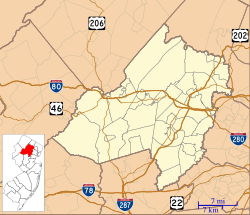Boisaubin Manor | |
 | |
| Location | Treadwell Avenue Chatham Township, New Jersey |
|---|---|
| Nearest city | Morristown, New Jersey |
| Coordinates | 40°46′03″N74°26′37″W / 40.76750°N 74.44360°W |
| Area | 9 acres (3.6 ha) |
| Built | 1822–1834 |
| Architectural style | Greek Revival |
| NRHP reference No. | 76001175 [1] |
| NJRHP No. | 2097 [2] |
| Significant dates | |
| Added to NRHP | October 22, 1976 |
| Designated NJRHP | June 13, 1973 |
Boisaubin Manor is a historic brick house located on Treadwell Avenue in the Convent Station section of Chatham Township, southeast of Morristown, in Morris County, New Jersey, United States. Built sometime between 1822 and 1834, it was added to the National Register of Historic Places on October 22, 1976, for its significance in art and architecture. [3]



